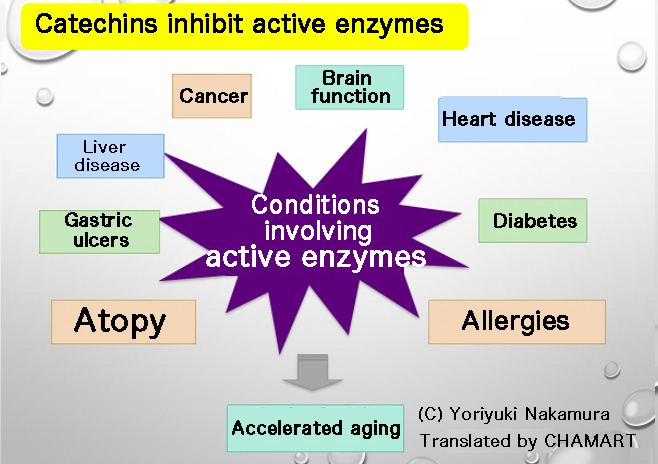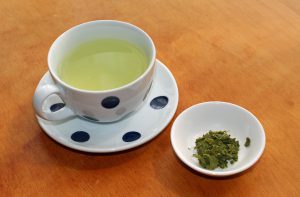MENU
MENU
Benefits of Tea
Benefits of Tea 4 “Catechins”

Professor Yoriyuki Nakamura of the University of Shizuoka wrote the original article in Japanese, which CHAMART translated into English.
Catechins
Tea catechins mainly include epicatechin (EC), epicatechin gallate (ECg), epigallocatechin (EGC), and epigallocatechin gallate (EGCg). Of these, epigallocatechin gallate accounts for more than half. Un-fermented tea, like green tea, contains a high proportion of catechins. Catechins in black and oolong tea, which are fermented, are reduced because they are oxidized and converted into theaflavins. Catechins in post-fermented tea, such as Pu’er tea, are lost because they are decomposed by filamentous fungus during sedimentation fermentation.

Sencha (medium-steamed green tea) and its used tea leaves
Catechins are the components that bring an astringent or bitter taste in tea. Gyokuro requires an umami taste. Therefore, the tea gardens of gyokuro are covered by komo (straw mats) or man-made black mats to block sunlight so that amino acids increase, but catechins are reduced in the tea leaves.
On the other hand, black tea requires a large amount of catechins for its refreshing astringency. However, catechins are polymerized and converted to theaflavins or thearubigins by the enzyme polyphenol oxidase, which decreases the catechin content.
Catechins have the strongest antioxidant effect among polyphenols, and exhibit a variety of functions, including anti-mutation, anti-cancer, anti-oxidation, anti-arteriosclerosis, suppression of blood cholesterol, suppression of fat absorption, antibacterial, anti-viral, caries prevention, improvement of intestinal flora, deodorization, and suppression of blood pressure.
Writer’s Profile
Yoriyuki Nakamura
Specially-appointed professor, Director of the Tea Science Center, University of Shizuoka
https://dfns.u-shizuoka-ken.ac.jp/labs/tsc/index.html
Awards and commendations
2016 Awarded as Japanese Tea Industry Achievement Award: Popularization of tea varieties and pot seedling cultivation techniques
2015 Awarded as O-CHA Pioneer Award of academic research section: Tea breeding technology and Variety development
2013 Awarded as Tea Industry Technology Merit Award: Efforts in tea industry technology
2013 Awarded as Sugiyama Hikosaburo Tea Technology Award: Developing tea variety
2013 Awarded as Tea Academic Research Award: Tea breeding and tea propagation technology
Related article on the site:
Benefits of Tea 1 “Tea has long been a powerful elixir with abundant benefits!”
Benefits of Tea 2 “Functional ingredient of Tea”
Benefits of Tea 3 “Major components of tea”
Benefits of Tea 4 “Catechins”
Benefits of Tea 5 “Amino acids”
Benefits of Tea 6 “Caffeine”
Benefits of Tea 7 “Vitamins”
CATEGORY